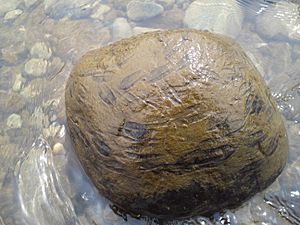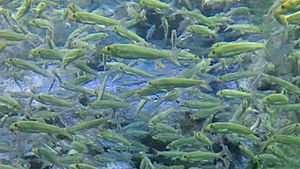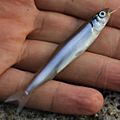Ayu sweetfish facts for kids
Quick facts for kids Ayu sweetfish |
|
|---|---|
 |
|
| Conservation status | |
| Scientific classification | |
| Synonyms | |
|
The ayu sweetfish (Plecoglossus altivelis), also called ayu or just sweetfish, is a type of fish. It is the only species in its group, Plecoglossus, and its family, Plecoglossidae. It is related to smelts and other fish in the Osmeriformes order.
Ayu sweetfish live naturally in East Asia. You can find them in the northwestern Pacific Ocean, from Hokkaidō in Japan down to the Korean Peninsula, China, Hong Kong, and northern Vietnam. These fish are amphidromous, which means they travel between salty ocean waters and fresh water in lakes and rivers. Some groups of ayu also live only in freshwater lakes in Japan, like Biwa. They have also been brought to Taiwan.
The name "sweetfish" comes from how sweet its meat tastes. People also call it "year-fish" because it usually lives for only one year. However, some ayu can live for two or three years. The ayu is an important fish in Gunma Prefecture and Gifu Prefecture in Japan.
Types of Ayu Sweetfish
Scientists sometimes recognize different types of ayu, called subspecies. Other experts do not separate them into smaller groups.
Some of these types include:
- P. a. altivelis (the common ayu or sweetfish)
- P. a. chinensis (the Chinese ayu)
- P. a. ryukyuensis (the Ryukyu ayu-fish), which is an endangered type.
Ayu Biology and Life
The ayu sweetfish is an omnivore, meaning it eats both plants and animals. It feeds on algae that grows on rocks, scraping it off with its special saw-shaped teeth. It also eats crustaceans, insects, sponges, and worms. Adult ayu usually claim a small area as their own feeding territory. However, ayu that live only in lakes and streams tend to swim in schools.
Most ayu populations are amphidromous. This means they breed in the lower parts of rivers during the autumn. They lay their eggs in small holes they dig in the gravel. The eggs hatch quickly, and the tiny larvae float down the river to the sea. They spend the winter in coastal areas. In the spring, the young fish, usually about 6 inches (15 cm) long, swim back up the rivers. By summer, they can grow to be 6 to 12 inches (15 to 30 cm) long.
By autumn, they are grown up and swim back down to the lower parts of rivers to breed. Some ayu die after breeding, living only one year. But others return to the ocean and can breed up to three times. Each time, they move into rivers in the autumn. In Japan, some ayu populations live their whole lives in freshwater, moving between lakes and the streams where they breed. These fish can live for two or three years.
Ayu can grow up to 28 inches (70 cm) long, but most are about 12 inches (30 cm). The ayu that live only in freshwater are usually smaller than those that travel to the ocean. For example, ayu from Lake Biwa that swim into streams in the spring can reach about 6 inches (15 cm). But those that migrate later in the year, in autumn, only grow to about 4 inches (10 cm). This difference is due to how much food is available to them.
How People Use Ayu
Ayu is a popular edible fish, especially in East Asia. Its meat has a special, sweet taste, sometimes described as having "melon and cucumber aromas." Because of this, it is highly valued as a food fish.
People catch ayu in different ways:
- Fly fishing
- Using a fish trap
- Fishing with a decoy: In Japan, this method is called ayu-no-tomozuri. A live ayu is put on a hook and placed in the water. This makes other ayu, which are very territorial, attack the "intruder" and get caught.
Japanese fishermen also catch ayu using cormorant fishing. On the Nagara River, fishermen use trained Japanese cormorants (Phalacrocorax capillatus). These birds, called umi-u in Japanese, catch the ayu, store them in their crop, and then give them to the fishermen. This fishing season attracts visitors from all over the world.
Ayu are also caught for sale by businesses. Young ayu are raised in aquaculture (fish farms) and then released into rivers for people to catch for sport.
A common way to prepare ayu and other small fish in Japan is to skewer them. They are skewered in a way that makes their body look like a wave, as if they are still swimming.
Images for kids
See also
 In Spanish: Ayu para niños
In Spanish: Ayu para niños








